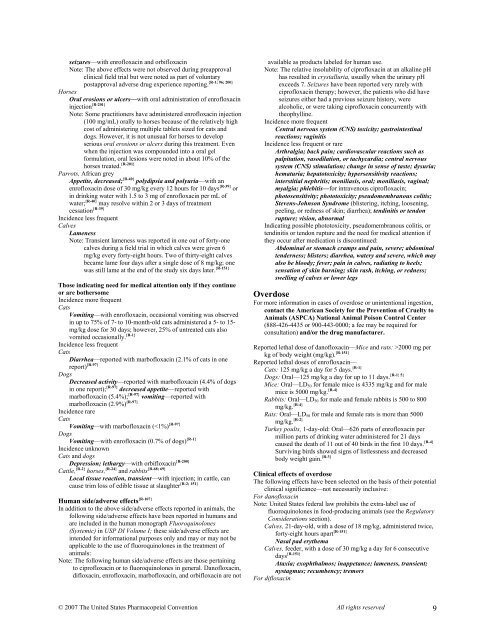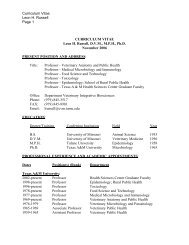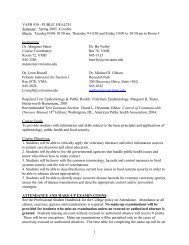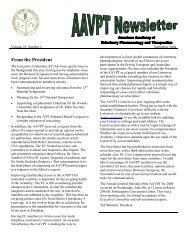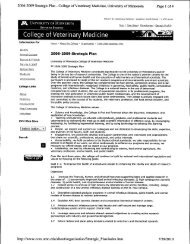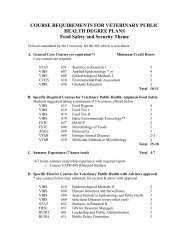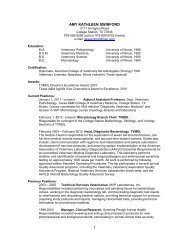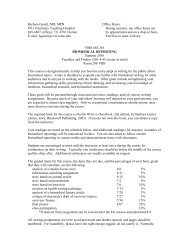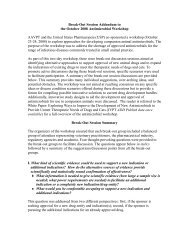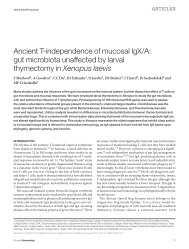FLUOROQUINOLONES (Veterinary—Systemic) - College of ...
FLUOROQUINOLONES (Veterinary—Systemic) - College of ...
FLUOROQUINOLONES (Veterinary—Systemic) - College of ...
You also want an ePaper? Increase the reach of your titles
YUMPU automatically turns print PDFs into web optimized ePapers that Google loves.
seizures—with enr<strong>of</strong>loxacin and orbifloxacin<br />
Note: The above effects were not observed during preapproval<br />
clinical field trial but were noted as part <strong>of</strong> voluntary<br />
{R-1; 96; 200}<br />
postapproval adverse drug experience reporting.<br />
Horses<br />
Oral erosions or ulcers—with oral administration <strong>of</strong> enr<strong>of</strong>loxacin<br />
injection {R-201}<br />
Note: Some practitioners have administered enr<strong>of</strong>loxacin injection<br />
(100 mg/mL) orally to horses because <strong>of</strong> the relatively high<br />
cost <strong>of</strong> administering multiple tablets sized for cats and<br />
dogs. However, it is not unusual for horses to develop<br />
serious oral erosions or ulcers during this treatment. Even<br />
when the injection was compounded into a oral gel<br />
formulation, oral lesions were noted in about 10% <strong>of</strong> the<br />
horses treated. {R-201}<br />
Parrots, African grey<br />
Appetite, decreased; {R-40} polydipsia and polyuria—with an<br />
enr<strong>of</strong>loxacin dose <strong>of</strong> 30 mg/kg every 12 hours for 10 days {R-39} or<br />
in drinking water with 1.5 to 3 mg <strong>of</strong> enr<strong>of</strong>loxacin per mL <strong>of</strong><br />
water; {R-40} may resolve within 2 or 3 days <strong>of</strong> treatment<br />
cessation {R-39}<br />
Incidence less frequent<br />
Calves<br />
Lameness<br />
Note: Transient lameness was reported in one out <strong>of</strong> forty-one<br />
calves during a field trial in which calves were given 6<br />
mg/kg every forty-eight hours. Two <strong>of</strong> thirty-eight calves<br />
became lame four days after a single dose <strong>of</strong> 8 mg/kg; one<br />
was still lame at the end <strong>of</strong> the study six days later. {R-151}<br />
Those indicating need for medical attention only if they continue<br />
or are bothersome<br />
Incidence more frequent<br />
Cats<br />
Vomiting—with enr<strong>of</strong>loxacin, occasional vomiting was observed<br />
in up to 75% <strong>of</strong> 7- to 10-month-old cats administered a 5- to 15mg/kg<br />
dose for 30 days; however, 25% <strong>of</strong> untreated cats also<br />
vomited occasionally. {R-1}<br />
Incidence less frequent<br />
Cats<br />
Diarrhea—reported with marb<strong>of</strong>loxacin (2.1% <strong>of</strong> cats in one<br />
report) {R-97}<br />
Dogs<br />
Decreased activity—reported with marb<strong>of</strong>loxacin (4.4% <strong>of</strong> dogs<br />
in one report); {R-97} decreased appetite—reported with<br />
marb<strong>of</strong>loxacin (5.4%); {R-97} vomiting—reported with<br />
marb<strong>of</strong>loxacin (2.9%) {R-97}<br />
Incidence rare<br />
Cats<br />
Vomiting—with marb<strong>of</strong>loxacin (2000 mg per<br />
kg <strong>of</strong> body weight (mg/kg). {R-151}<br />
Reported lethal doses <strong>of</strong> enr<strong>of</strong>loxacin—<br />
Cats: 125 mg/kg a day for 5 days. {R-1}<br />
Dogs: Oral—125 mg/kg a day for up to 11 days.<br />
© 2007 The United States Pharmacopeial Convention All rights reserved 9<br />
{R-1; 5}<br />
Mice: Oral—LD50 for female mice is 4335 mg/kg and for male<br />
mice is 5000 mg/kg. {R-4}<br />
Rabbits: Oral—LD50 for male and female rabbits is 500 to 800<br />
mg/kg. {R-4}<br />
Rats: Oral—LD50 for male and female rats is more than 5000<br />
mg/kg. {R-2}<br />
Turkey poults, 1-day-old: Oral—626 parts <strong>of</strong> enr<strong>of</strong>loxacin per<br />
million parts <strong>of</strong> drinking water administered for 21 days<br />
caused the death <strong>of</strong> 11 out <strong>of</strong> 40 birds in the first 10 days. {R-4}<br />
Surviving birds showed signs <strong>of</strong> listlessness and decreased<br />
body weight gain. {R-3}<br />
Clinical effects <strong>of</strong> overdose<br />
The following effects have been selected on the basis <strong>of</strong> their potential<br />
clinical significance—not necessarily inclusive:<br />
For dan<strong>of</strong>loxacin<br />
Note: United States federal law prohibits the extra-label use <strong>of</strong><br />
fluoroquinolones in food-producing animals (see the Regulatory<br />
Considerations section).<br />
Calves, 21-day-old, with a dose <strong>of</strong> 18 mg/kg, administered twice,<br />
forty-eight hours apart {R-151}<br />
Nasal pad erythema<br />
Calves, feeder, with a dose <strong>of</strong> 30 mg/kg a day for 6 consecutive<br />
days {R-151}<br />
Ataxia; exophthalmos; inappetance; lameness, transient;<br />
nystagmus; recumbency; tremors<br />
For difloxacin


